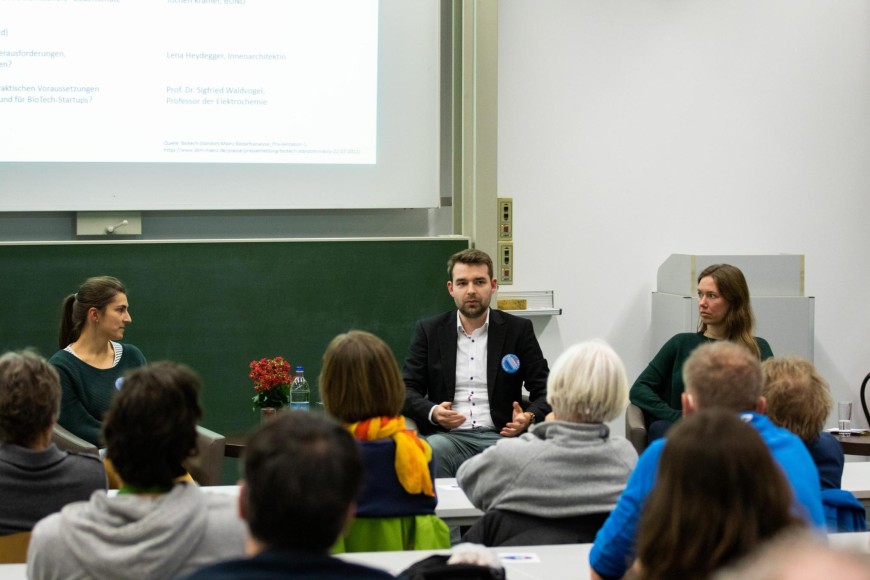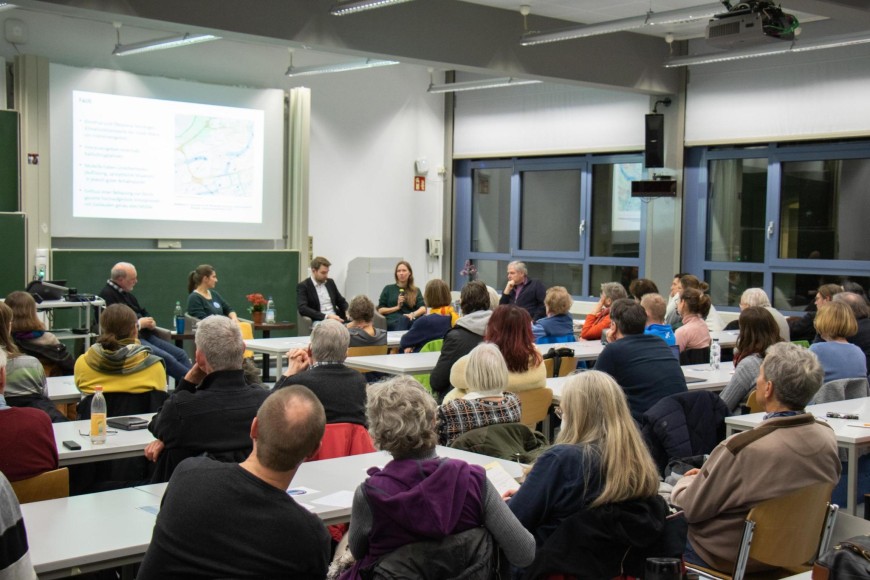Biotechnology Campus Mainz: How are future special areas to be developed?
2023/01/10
Panel discussion on land sealing in outdoor areas versus use of dispersed existing structures in indoor areas
Mainz, the capital of Rhineland-Palatinate, is planning to establish a regional innovation system for biotechnology. For this purpose, a campus is to be developed on the outskirts, as an extension to the Johannes Gutenberg University and the Mainz University of Applied Sciences. The Mainz chapter of Scientists4Future organised a panel discussion in which the planning for the biotechnology campus was critically examined in the context of climate change and climate adaptation. Our research assistant Benjamin D. Kraff took over the technical moderation and contrasted some arguments together with the panel.
It is the first public evening event of Scientists4Future Mainz in the new year, but the seminar room at the Johannes Gutenberg University (JGU) was almost filled to capacity with about 80 people. The interest in the climatic effects of a campus development in the outer area of Mainz was high, but other technical topics were also to be discussed and needs identified.
The approximately 90-minute meeting started with a presentation of background information on the planned area by Apl.-Prof. Nadja Hellmann (Scientists4Future). Facts and figures were presented and then the floor was turned over to the panel. A total of four guests from very different fields were invited.
Dr. Franziska Teubler, research associate at the Institute for Atmospheric Physics (JGU), explained the results of studies conducted so far. She explained the possible effects of the planned development on the cold air production area there and air currents that supply the city centre of Mainz with fresh air. A reduction in the flow velocity as well as a lack of cold air can ultimately lead to further warming of urban areas.
The effects of additional large-scale land sealing were also explained by Jochem Kramer, member of the state board of the Bund für Umwelt und Naturschutz Deutschland (BUND). According to this, in addition to climate impacts, not only biodiversity but also the water balance and other soil factors must be taken into account.
During the discussion, it became clear that campus development in the outdoor area must also be contrasted with the possible use of fallow conversion areas, empty office buildings and gaps between buildings in the indoor area. Interior designer Lena Heydegger, who specialises in sustainable commercial interior design, showed the potential of using existing structures, but also revealed the challenges, especially when special requirements are placed on the technical building equipment.
Prof. Siegfried R. Waldvogel from the Department of Chemistry (JGU) made it clear that the need for additional laboratory space for science and research in Mainz is high. Additional buildings need to be developed, and the proximity to the university also offers its advantages. However, he too advocates sustainable use of existing open spaces, but also points out – when it comes to the use of inner-city spaces – the conflicts regarding area typologies, as special biotechnology areas should not be mixed with residential development.
After a lively discussion, various challenges were presented and questions from the audience were also answered. Further development depends on the objectives of the state capital and the state of Rhineland-Palatinate and remains open at the present time.
Report from the press: https://www.allgemeine-zeitung.de/lokales/mainz/stadt-mainz/scientists-for-future-2200934



